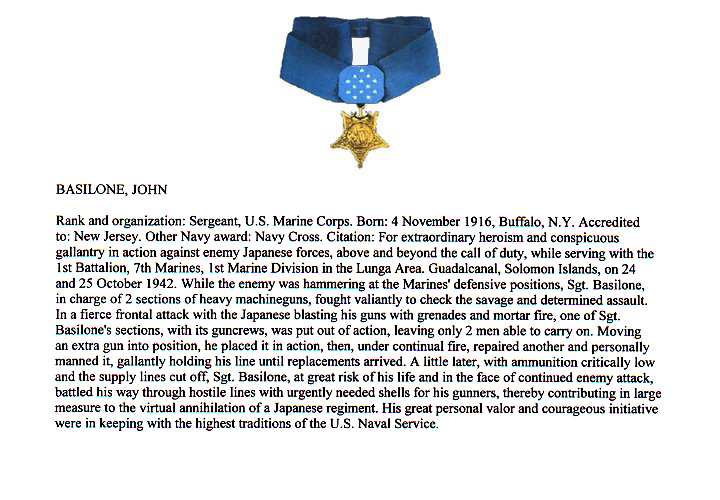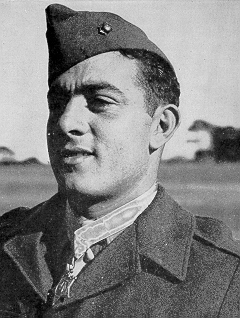BASILONE-JOHN
JOHN A. "MANILA JOHN" BASILONE

GYSGT

USS BASILONE DD-824 NAMED IN HIS HONOR
USS BASILONE DDG-122 NAMED IN HIS HONOR

WHO WAS JOHN BASILONE?
Article published in San Diego Union-Tribune on October 17, 2012:
A bronze bust of Gunnery Sergeant Basilone sits in a plaza named after him in the Little Italy area of San Diego. A road at the north end of Camp Pendleton bears his name. A sign along Interstate-5 near the base tells drivers they are on “Gunnery Sergeant John Basilone Memorial Highway,” leading some to ask “Who was Basilone?”
He was a World War II Marine hero based at Camp Pendleton. After receiving the Medal of Honor, the nation’s highest military award, he returned to fight in the Pacific at Iwo Jima, where he earned the Navy Cross posthumously at age 28. When Basilone received the Medal of Honor in 1942 he was said to have responded, “Only part of this medal belongs to me. Pieces of it belong to the boys who are still on Guadalcanal.” Basilone landed on Guadalcanal in the Solomon Islands on Sept. 17, 1942, and within weeks was in the middle of one of the campaign’s fiercest battles. His unit, led by COL Lewis B. “Chesty” Puller, was spread thinly along one side of Henderson Field at Guadalcanal, referred to later as “Coffin Corner.” Just after 10 p.m. on October 24, the Japanese launched a heavy attack. Basilone was in charge of two gun crews. A runner reported that the two guns on his right had jammed. So, Basilone grabbed a machine gun to defend the spot. He got the guns working, firing one and then the other as the enemy attacked throughout the night, and held off several thousand Japanese with only 15 men. He ran through enemy territory to get more ammunition, and after the battle, 1,000 enemy dead were counted, according to the Naval History Center in Washington, D.C. Basilone was awarded the Medal of Honor and promoted to Gunnery Sergeant.
He sold war bonds briefly but wanted to return to the fight. While at Camp Pendleton for training he met Lena Mae Riggi, a Sergeant in the Marine Corps Women’s Reserve. They were married in July 1944 at St. Mary’s Star of the Sea Church in Oceanside. Basilone requested a return to the Pacific Theater and served as a machine gun section leader with the 1st Battalion, 27th Marines, 5th Marine Division, during the initial assault on the island of Iwo Jima. “The Japanese were strongly entrenched on that Pacific island. They were dug into the cliffs with artillery. There were thousands of gun positions, with underground tunnels connecting them ... some of the tunnels 35 feet underground,” according to a 1975 article in the Marine Corps Associations publication The Leatherneck.
On February 19, 1945, shortly after single-handedly destroying a blockhouse on Iwo Jima’s Red Beach and guiding a trapped tank out of a minefield under attack, Basilone was killed by a mortar shell. “Gunnery Sergeant Basilone boldly defied the smashing bombardment of heavy caliber fire to work his way around the flank and up to a position directly on top of the blockhouse and then, attacking with grenades and demolitions, single-handedly destroyed the entire hostile strong point and its defending garrison,” according to his Navy Cross citation. His actions helped Marines break down the Japanese defense during the crucial early parts of the invasion. “In the forefront of the assault at all times, he pushed forward with dauntless courage and iron determination,” the citation said.
Basilone, whose father emigrated from Naples, Italy, in the early 1900s, was born in Buffalo, N.Y. He enlisted in the Army at age 18, serving three years in the Philippines and earning the nickname “Manila John” for the stories he recounted about the islands. He joined the Marine Corps in 1940. He is remembered in landmarks across the country, on a Navy ship the USS BASILONE, and on U.S. postage stamps issued in 2005. In 2010, the HBO series, “The Pacific,” depicted his feats and those of two other Marines in the Pacific during WWII. Gunnery Sergeant Basilone has been laid to rest at Arlington National Cemetery.
Submitted by CDR Roy A. Mosteller, USNR (Ret)

